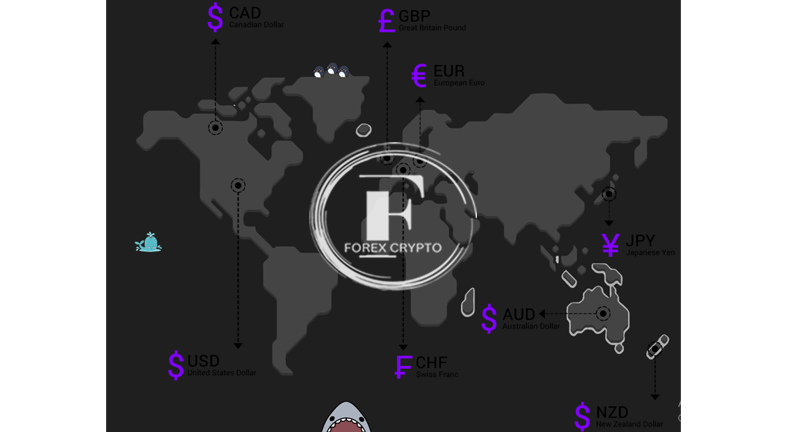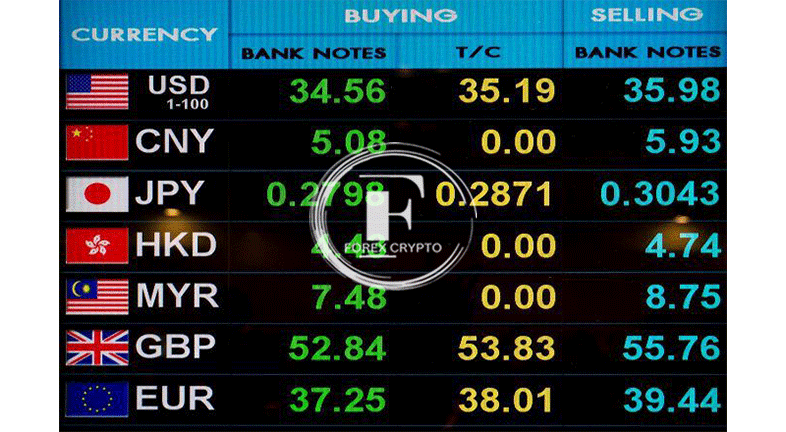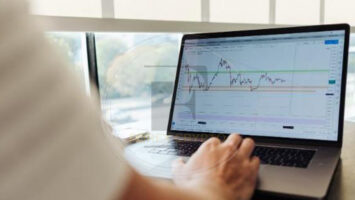A number of different macroeconomic variables, as well as the state of the economy in the rest of the globe, may have an effect on a nation’s foreign exchange currency. The value of a currency on the foreign exchange market is primarily determined by macro indicators such as economic indicators (such as GDP growth and imports/exports), social factors (such as the unemployment rate and the state of the country’s infrastructure or the conditions of the real estate market), and the policies of the country’s central bank (such as the RBI in India).
Major Currencies
In this part, you will get an understanding of the distinctive characteristics of the six most important currencies.
The US Dollar
The value of the US Dollar is very dominant in the global currency exchange market. The United States Dollar (USD) serves as the benchmark or standard currency against which all other currencies traded on the foreign exchange market are judged. Almost all currency prices are almost always expressed in terms of the US dollar.
Presently, the US dollar accounts for around 86% of all foreign currency market transactions. The majority of commodities (metals, oil, etc.) are traded with prices denominated in US Dollars; as a consequence, variations in supply and demand have a direct effect on the value of the US Dollar. During the 2008 financial crisis, when oil prices plummeted and the EUR/USD rose to 1.60, this occurred.
Because of its reputation as a refuge currency, the US dollar is often used. As a result, investors seek safety in the United States dollar whenever the economic environment deteriorates.
The Euro (EUR)
The Euro now holds the position as the second most dominant currency on the foreign exchange market. Along the same lines as the United States Dollar, the Euro has achieved a high level of worldwide recognition thanks to the countries that make up the European Monetary Union.
The Euro is the official currency of 18 nations that are members of the European Union, and it accounts for roughly 37% of all currency exchanges that take place right now.

The primary reasons that have a significant impact on the acceptability of Euro pricing are often based on the economies of well-established nations (developed countries) that make use of the common currency, such as France and Germany. The value of the euro is influenced by a number of factors, including the Consumer Price Index (CPI) of significant nations (including Germany), the European Central Bank, the unemployment rate, and export statistics.
The Euro is the single currency used across all of Europe, yet the individual economies of different nations are rather distinct from one another, as was made abundantly clear during the debt crisis that occurred in 2011. This limits the dominance of the euro in the foreign exchange market throughout the world. When there are issues, the leaders of the EU have a difficult time coming up with consensus solutions that are advantageous to both the major and the small economies.
The Japanese Yen (JPY)
In the Asian currency market, the Japanese yen is the currency that is exchanged the most and has the greatest influence. It is the third most popular or traded currency in the foreign exchange market, and it accounts for over 20% of the total exchange that takes place throughout the globe. The natural need to trade the yen comes mostly from the Japanese Keiretsu, which are conglomerates that operate in the economic and financial sectors. The volatility of the Japanese yen is correlated with the Japanese stock market, namely the Nikkei index, as well as the real estate market in Japan (JPY).
The Japanese yen (JPY) is regarded as a safe-haven currency among traders and investors at times when risk aversion is prevalent on the market. This is mostly due to the fact that the Japanese economy is predominantly based on industrial exports. Since interest rates in Japan are so low, traders may get loans at reasonable rates and use the money to invest in other nations.
The hazards associated with the JPY’s currency are due to the continuous depreciation of the currency as well as the interventions carried out by the central bank of the nation. Since Japan’s economy is so dependent on exports, the nation’s central bank is always working to make the yen more competitive against other currencies.

The British Pound (GBP)
The term “British Pound” refers to the unit of money that is used across the United Kingdom. Up to the conclusion of World War II, the pound remained to have the same level of dominance in the foreign exchange market as the dollar does now and was the currency that was used for reference. The British pound is frequently traded in comparison to the euro and the US dollar, but its presence is much lower in comparison to other currencies.
The British Pound (abbreviated as GBP) is the fourth most traded currency in the world, and around 17% of all transactions in the global forex market are conducted via the use of GBP. While London is often regarded as the center of the global foreign exchange market, 34% of all foreign exchange transactions are conducted in London City.
The basic elements that determine the value of the pound are just as complicated and diverse as the economy of the United Kingdom and its role in the global economy. The value of the pound is affected by inflation, the Economy of the nation, and the property market.
Forex traders may sometimes employ the pound as an alternative to the euro, particularly in times when the issues facing the European Union are very severe.
The Swiss Franc (CHF)
The Swiss Franc is the country’s official currency and legal money. CHF is the currency code for the Swiss franc, and the CHF/EUR currency combination is the most common Swiss franc exchange rate. It is also the only major European currency that is not a member of the European Union or the Group of Seven. Despite the relatively modest size of the Swiss economy, the Swiss franc is one of the four main currencies traded on the foreign exchange market, closely reflecting the strength and quality of the Swiss economy and finance.
The credibility of the Swiss franc is bolstered by the fact that the Swiss economy and its foreign reserves, which are primarily made up of gold and rank as the seventh largest in the world, respectively. In addition, the CHF is regarded as a safe-haven currency, and investors gravitate towards it during times when they are unwilling to take risks.
Prices in CHF are determined by the policies of the central bank. Since there is less liquidity in the CHF market than there is in markets for other major currencies, the CHF is often more volatile.
The Canadian Dollar (CAD)
The Canadian dollar is largely influenced by the price of commodities. This is due to the fact that the Canadian economy is based on exports, and the primary commodity that is sent out is crude oil. As a consequence of this, the price of crude oil has an impact on the value of the Canadian dollar.
Growth in economic activity throughout the world and advancements in technology both contribute to the attractiveness of CAD as an investment opportunity.
Different Trade Systems on Forex
In the international currency exchange market, there are a few distinct methods that trades may be conducted. The following is a description of the trading systems that are widely used in the foreign exchange market:
Trading with brokers
The foreign exchange broker, often known as the forex broker or the currency-trading broker, does not maintain positions, in contrast to equities or commodities brokers. The provision of service to financial institutions is the primary goal of these brokers. They operate as middlemen, buying and selling currencies at commission rates in order to make a profit.
Prior to the widespread use of the Internet, the vast majority of FX brokers handled customer orders using an open box system that was conducted over the phone. A microphone was installed at the broker’s desk, and it continually sent all of the broker’s conversations that took place over the direct phone lines to the speaker’s boxes located in the banks. In this manner, banks were also able to get all of the business orders.
A trader is able to hear all of the prices that are being mentioned when the broker is using a system called an open box. This system also indicates whether the bid was completed or the offer (ask) was accepted, as well as the price that came next. The trader is kept in the dark about the quantities of specific bids and offers, as well as the identities of the institutions whose prices are being shown. Prices were not disclosed, and both buyers and sellers remained nameless throughout the transaction.
In this day and age of the Internet, many brokers have enabled their customers to access their accounts and make trades using electronic platforms (usually via their own proprietary software) and computer programs.
Direct Dealing
The concept of mutual benefit underpins the direct dealing economy. When a bank sets a price, it does so with the assumption that another bank that has turned to it would respond with mutuality by setting its own price when it, in turn, turns to the bank. This assumption is shared by all players in the currency market. As compared to dealing via a broker, direct dealing allows for more flexibility in action-taking. There are occasions when traders make use of this quality.
Formerly, all business was conducted directly over the telephone. This opened the door for errors that were unable to be located and corrected for whatever reason. The era of direct dealing gave way to the era of dealing systems in the middle of the 1980s.
Dealing systems are computer networks that connect the many banks from across the globe that provide funds. Every computer has its own individual terminal connection. It is possible to connect to a bank considerably more quickly via the dealing system than it is to connect over the phone. Every day brings improved levels of safety to the trading platforms. Speed, safety, and dependability are the three characteristics that best describe the functioning of the dealing system. The information that is constantly changing on the trader’s terminal or monitor is in constant visual touch with them. Instead of being heard during the switches or throughout the discussions, it is more pleasant to have this knowledge.
A great number of financial institutions make use of both brokers and direct trading platforms. A single bank may use any of these two strategies, but not simultaneously in the same market.
Matching Systems
Comparing matching systems to dealing systems reveals a significant difference between the two. Trading in matching systems is anonymous, and individual traders engage in transactions against the rest of the market. This is analogous to trading in the broker’s market, but it differs from trading in dealing systems, in which trading is not anonymous and is carried out on a one-to-one basis. In contrast to the broker’s market, there are no individuals who are responsible for bringing prices to the market, and the amount of liquidity that is available might be restricted at times.
Matching systems may be characterized by a variety of features, including speed, safety, and dependability, much like the dealing system that we use. The credit lines are automatically controlled by the computers, which is one of the benefits of using a matching system.
While transacting in the interbank market, traders interact directly with dealing systems, matching systems, and brokers in a manner that is complimentary.




Comments (No)